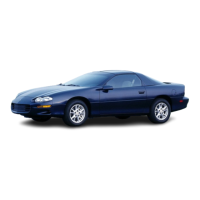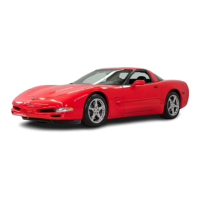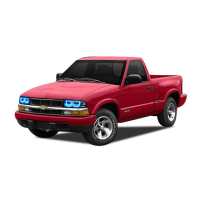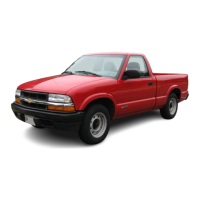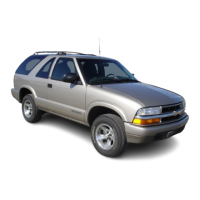Do you have a question about the Chevrolet 1998 Cavalier and is the answer not in the manual?
This section details seat adjustments and head restraint usage, covering manual and powered seat operation.
Explains proper safety belt usage, including precautions and the Supplemental Restraint System (SRS).
Provides instructions for adults on wearing safety belts correctly, covering driver and passenger positions.
Describes the driver’s restraint system, focusing on lap-shoulder belt usage and adjustment.
Offers guidance on proper safety belt use for pregnant women to ensure fetus and mother safety.
Explains the vehicle’s air bag system, its function, and how it works with safety belts.
Emphasizes the importance of rear seat passengers buckling up for their own safety and that of others.
Details the use of comfort guides to improve rear shoulder belt fit for children and small adults.
Highlights the critical need for appropriate child restraints and legal requirements for child safety.
Discusses various types of child restraints, including infant car beds, rear-facing, and forward-facing seats.
Advises on using vehicle safety belts for children who have outgrown child restraints.
Explains how to use and obtain a safety belt extender if the standard belt is not long enough.
Guides on when safety belts and restraint system parts need replacement after a collision.
Discusses vehicle key usage, the importance of an extra key, and the dangers of leaving keys in the ignition.
Explains how to lock and unlock doors using keys, levers, and the optional remote keyless entry system.
Details the operation of the remote keyless entry system for locking, unlocking, and trunk release.
Explains the five ignition switch positions (Accessory, Lock, Off, Run, Start) and their functions.
Provides instructions for starting the engine on both automatic and manual transaxle vehicles.
Details the operation of three-speed and four-speed automatic transaxles and gear positions.
Guides on operating the manual transaxle, including shift patterns and clutch usage.
Locates the parking brake lever and explains how to set and release it.
Explains manual window cranks and power window operation, including the lockout switch.
Describes how to adjust the steering wheel for comfort and easier entry/exit.
Details the functions of the lever, including turn signals, headlamps, and cruise control.
Explains how to operate the windshield wipers and washers, including variable delay settings.
Covers setting, resuming, increasing, and reducing speed with cruise control.
Explains the operation of parking lamps, headlamps, and daytime running lamps.
Details the operation of interior lights, instrument panel illumination, and illuminated entry features.
Covers the inside rearview mirror and manual remote control outside mirrors, including adjustment.
Explains the operation of power-controlled outside mirrors and the function of convex mirrors.
Describes the center console storage area and the convenience net in the trunk.
Provides instructions for the proper operation of the convertible top, including warnings.
Provides an overview of the instrument panel components and their functions.
Describes the standard and optional instrument panel clusters, including warning lights and gauges.
Explains the function of the speedometer and odometer, including odometer replacement.
Introduces warning lights and gauges that signal vehicle conditions and potential problems.
Explains the function of the safety belt reminder light and associated chime.
Describes the air bag readiness light, its normal operation, and what it indicates when it stays on.
Emphasizes being prepared for unexpected situations and maintaining a safe following distance.
Highlights the dangers of drinking and driving, affecting judgment, coordination, and reaction time.
Explains the three core systems (brakes, steering, accelerator) and how losing traction can lead to loss of control.
Details perception and reaction time in braking, stopping distances, and avoiding heavy braking.
Explains how the ABS system helps prevent braking skids and how it functions during emergency stops.
Describes the ETS feature that limits wheel spin, particularly useful in slippery conditions.
Discusses steering operation, including power steering assist and tips for safe steering.
Covers emergency steering techniques, emphasizing quick reactions and control.
Provides guidance on how to recover the vehicle if its wheels drop off the road onto the shoulder.
Offers tips for safely passing other vehicles on two-lane highways, stressing caution and observation.
Explains how loss of control occurs when vehicle systems exceed tire traction and road conditions.
Discusses types of skids (braking, steering, acceleration) and how to handle them.
Provides tips for safer night driving, including adjusting mirrors and maintaining awareness.
Advises on driving cautiously in wet conditions due to reduced traction and visibility.
Warns about the dangers of driving through deep water, including engine damage and wet brakes.
Offers tips for preparing the vehicle and driving safely in winter conditions.
Details how to drive cautiously on slippery surfaces like snow and ice, emphasizing gentle inputs.
Provides safety advice for being stranded in a blizzard, including summoning help and staying warm.
Guides on towing the vehicle behind another vehicle for recreational purposes, stressing proper equipment.
Outlines the steps for towing the vehicle using a dolly, including fuse removal and steering wheel locking.
Explains how to tow the vehicle with all four wheels on the ground, detailing procedures for specific transaxle types.
Warns against towing the vehicle from the rear due to potential damage and warranty voiding.
Provides information on vehicle weight limits, tire loading labels, and proper cargo distribution.
Details trailer towing capabilities and requirements for specific engine/transaxle configurations.
Offers important points and safety rules for trailer towing, including laws, sway control, and initial break-in.
Explains the importance of tongue load and its impact on vehicle weight distribution for safe towing.
Advises on proper tire inflation and not exceeding the vehicle’s Gross Vehicle Weight Rating (GVWR).
Stresses the importance of using the correct hitch equipment and proper installation methods.
Guides on the proper attachment and use of safety chains between the vehicle and trailer for secure towing.
Instructs on installing, adjusting, and maintaining trailer brakes, warning against tampering with the vehicle’s ABS.
Emphasizes gaining experience with trailer handling, braking, and pre-trip checks.
Explains how trailer towing affects turn signal operation and the importance of checking trailer lights.
Provides advice on driving on steep grades, including gear selection and cooling system management.
Offers steps for safely parking a vehicle with a trailer attached on a hill.
Highlights key maintenance items that require more frequent attention when towing a trailer.
Addresses potential engine overheating during towing and refers to the engine overheating section.
Lists conditions under which towing a trailer is not permitted (e.g., convertible, specific engines/transaxles).
Explains the function of hazard warning flashers for signaling problems and their operation independent of the ignition.
Provides detailed, safe instructions for jump-starting a vehicle using jumper cables and another vehicle.
Recommends professional towing services and outlines information to provide to the service provider.
Addresses symptoms of engine overheating, especially steam, and immediate actions to take.
Identifies key components of the cooling system under the hood, such as the coolant surge tank and fan.
Explains how to handle a tire blowout or slow leak, including steering and braking actions.
Guides on safely changing a flat tire, including securing the vehicle and using the jack.
Details the use, inflation pressure, and limitations of the compact spare tire.
Offers advice on getting unstuck, including the "rocking" method and avoiding wheel spin.
Encourages using GM dealers for service and highlights genuine GM parts and trained personnel.
Specifies the recommended octane rating and types of gasoline for the vehicle.
Explains the procedure for refueling, including safety precautions with gasoline vapor.
Introduces the process of checking underhood fluids, lubricants, and components, with safety warnings.
Guides on checking engine oil level, location of dipstick for different engines, and proper procedure.
Explains the location and procedure for checking or replacing the air cleaner filter.
Details when to check and change the automatic transaxle fluid, especially under severe conditions.
Explains how to check manual transaxle fluid level and notes that fluid does not require changing.
Describes the self-adjusting hydraulic clutch system and fluid check procedure.
Explains the DEX-COOL® coolant system, its properties, and how to add coolant if low.
Explains the reasons for brake fluid level changes and the importance of using the correct fluid type.
Explains how to identify brake pad wear through warning sounds and inspects drum brake linings.
Stresses using genuine GM replacement parts for the braking system to ensure proper function and safety.
Recommends ACDelco Freedom® batteries and provides information on vehicle storage procedures.
Directs users to contact the dealer for bulb replacement procedures not covered in the manual.
Guides on how to replace headlamp bulbs, including accessing the bulb assembly.
Guides on replacing bulbs for dome lamps with and without integral reading lamps.
Explains how to remove and install windshield wiper blades, specifically the Shepherd’s Hook type.
Discusses the importance of proper tire maintenance, including inflation and avoiding overloading.
Provides indicators for determining when tires need replacement, such as treadwear indicators and visible damage.
Advises on selecting the correct tire size and type, emphasizing matching TPC Spec numbers and avoiding mixing tire types.
Explains the NHTSA tire grading system for treadwear, traction, and temperature performance.
Discusses the importance of proper wheel alignment and balance for tire life and vehicle performance.
Stresses the importance of applying anti-corrosion material after sheet metal repair or replacement.
Recommends flushing the underbody with plain water each spring to remove corrosive materials from road treatments.
Explains the location and importance of the VIN as a legal identifier for the vehicle.
Add-on Electrical Equipment
Explains how fuses and circuit breakers protect wiring from short circuits and electrical damage.
Provides approximate capacities for various fluids and specifications for engine, transmission, and cooling system.
Explains the importance of proper vehicle maintenance for safety, dependability, and environmental protection.
Outlines scheduled maintenance services, advising professional service for complex tasks.
Defines conditions that qualify for the Short Trip/City Maintenance Schedule, such as frequent short trips and idling.
Lists specific maintenance services and their recommended intervals for short trip/city driving conditions.
Defines conditions that qualify for the Long Trip/Highway Maintenance Schedule, emphasizing consistent driving.
Lists specific maintenance services and their recommended intervals for long trip/highway driving conditions.
Details owner checks and services to be performed at specified intervals for vehicle upkeep.
Lists underhood checks to be performed at each fuel fill, including engine oil and coolant levels.
Covers monthly checks such as tire inflation and cassette deck cleaning for vehicle maintenance.
Details semi-annual checks including restraint systems, wiper blades, and transaxle fluid levels.
Outlines annual services like key lock cylinder lubrication and body lubrication.
Provides steps to check the starter switch operation, emphasizing safety precautions due to potential vehicle movement.
Explains how to check the BTSI system to ensure the vehicle cannot be shifted out of PARK without brake application.
Lists inspections and services recommended at least twice a year, suggesting dealer or qualified center performance.
Lists recommended fluids and lubricants by name, part number, or specification for vehicle maintenance.
Provides a section to record maintenance performed, including date, mileage, and service provider.
Outlines steps for resolving customer concerns, starting with dealership management contact.
Provides contact information and TTY services for customers with hearing or speech impairments.
Details the free roadside assistance program, including toll-free numbers and service levels.
Explains the roadside assistance program for Canadian vehicles, accessible nationwide.
Describes the courtesy transportation options available for warranty repairs, including shuttle rides and rental allowances.
Explains GM's participation in BBB AUTO LINE for resolving automotive disputes and the process involved.
Instructs how to report vehicle safety defects to NHTSA and the purpose of such reporting.
Advises Canadian residents to notify Transport Canada and General Motors of Canada about vehicle safety defects.
Encourages reporting vehicle safety defects directly to General Motors for prompt attention.
Provides information on how to purchase service manuals and owner literature for General Motors vehicles in Canada.
Refers to a separate warranty booklet for detailed warranty information.
This section details seat adjustments and head restraint usage, covering manual and powered seat operation.
Explains proper safety belt usage, including precautions and the Supplemental Restraint System (SRS).
Provides instructions for adults on wearing safety belts correctly, covering driver and passenger positions.
Describes the driver’s restraint system, focusing on lap-shoulder belt usage and adjustment.
Offers guidance on proper safety belt use for pregnant women to ensure fetus and mother safety.
Explains the vehicle’s air bag system, its function, and how it works with safety belts.
Emphasizes the importance of rear seat passengers buckling up for their own safety and that of others.
Details the use of comfort guides to improve rear shoulder belt fit for children and small adults.
Highlights the critical need for appropriate child restraints and legal requirements for child safety.
Discusses various types of child restraints, including infant car beds, rear-facing, and forward-facing seats.
Advises on using vehicle safety belts for children who have outgrown child restraints.
Explains how to use and obtain a safety belt extender if the standard belt is not long enough.
Guides on when safety belts and restraint system parts need replacement after a collision.
Discusses vehicle key usage, the importance of an extra key, and the dangers of leaving keys in the ignition.
Explains how to lock and unlock doors using keys, levers, and the optional remote keyless entry system.
Details the operation of the remote keyless entry system for locking, unlocking, and trunk release.
Explains the five ignition switch positions (Accessory, Lock, Off, Run, Start) and their functions.
Provides instructions for starting the engine on both automatic and manual transaxle vehicles.
Details the operation of three-speed and four-speed automatic transaxles and gear positions.
Guides on operating the manual transaxle, including shift patterns and clutch usage.
Locates the parking brake lever and explains how to set and release it.
Explains manual window cranks and power window operation, including the lockout switch.
Describes how to adjust the steering wheel for comfort and easier entry/exit.
Details the functions of the lever, including turn signals, headlamps, and cruise control.
Explains how to operate the windshield wipers and washers, including variable delay settings.
Covers setting, resuming, increasing, and reducing speed with cruise control.
Explains the operation of parking lamps, headlamps, and daytime running lamps.
Details the operation of interior lights, instrument panel illumination, and illuminated entry features.
Covers the inside rearview mirror and manual remote control outside mirrors, including adjustment.
Explains the operation of power-controlled outside mirrors and the function of convex mirrors.
Describes the center console storage area and the convenience net in the trunk.
Provides instructions for the proper operation of the convertible top, including warnings.
Provides an overview of the instrument panel components and their functions.
Describes the standard and optional instrument panel clusters, including warning lights and gauges.
Explains the function of the speedometer and odometer, including odometer replacement.
Introduces warning lights and gauges that signal vehicle conditions and potential problems.
Explains the function of the safety belt reminder light and associated chime.
Describes the air bag readiness light, its normal operation, and what it indicates when it stays on.
Emphasizes being prepared for unexpected situations and maintaining a safe following distance.
Highlights the dangers of drinking and driving, affecting judgment, coordination, and reaction time.
Explains the three core systems (brakes, steering, accelerator) and how losing traction can lead to loss of control.
Details perception and reaction time in braking, stopping distances, and avoiding heavy braking.
Explains how the ABS system helps prevent braking skids and how it functions during emergency stops.
Describes the ETS feature that limits wheel spin, particularly useful in slippery conditions.
Discusses steering operation, including power steering assist and tips for safe steering.
Covers emergency steering techniques, emphasizing quick reactions and control.
Provides guidance on how to recover the vehicle if its wheels drop off the road onto the shoulder.
Offers tips for safely passing other vehicles on two-lane highways, stressing caution and observation.
Explains how loss of control occurs when vehicle systems exceed tire traction and road conditions.
Discusses types of skids (braking, steering, acceleration) and how to handle them.
Provides tips for safer night driving, including adjusting mirrors and maintaining awareness.
Advises on driving cautiously in wet conditions due to reduced traction and visibility.
Warns about the dangers of driving through deep water, including engine damage and wet brakes.
Offers tips for preparing the vehicle and driving safely in winter conditions.
Details how to drive cautiously on slippery surfaces like snow and ice, emphasizing gentle inputs.
Provides safety advice for being stranded in a blizzard, including summoning help and staying warm.
Guides on towing the vehicle behind another vehicle for recreational purposes, stressing proper equipment.
Outlines the steps for towing the vehicle using a dolly, including fuse removal and steering wheel locking.
Explains how to tow the vehicle with all four wheels on the ground, detailing procedures for specific transaxle types.
Warns against towing the vehicle from the rear due to potential damage and warranty voiding.
Provides information on vehicle weight limits, tire loading labels, and proper cargo distribution.
Details trailer towing capabilities and requirements for specific engine/transaxle configurations.
Offers important points and safety rules for trailer towing, including laws, sway control, and initial break-in.
Explains the importance of tongue load and its impact on vehicle weight distribution for safe towing.
Advises on proper tire inflation and not exceeding the vehicle’s Gross Vehicle Weight Rating (GVWR).
Stresses the importance of using the correct hitch equipment and proper installation methods.
Guides on the proper attachment and use of safety chains between the vehicle and trailer for secure towing.
Instructs on installing, adjusting, and maintaining trailer brakes, warning against tampering with the vehicle’s ABS.
Emphasizes gaining experience with trailer handling, braking, and pre-trip checks.
Explains how trailer towing affects turn signal operation and the importance of checking trailer lights.
Provides advice on driving on steep grades, including gear selection and cooling system management.
Offers steps for safely parking a vehicle with a trailer attached on a hill.
Highlights key maintenance items that require more frequent attention when towing a trailer.
Addresses potential engine overheating during towing and refers to the engine overheating section.
Lists conditions under which towing a trailer is not permitted (e.g., convertible, specific engines/transaxles).
Explains the function of hazard warning flashers for signaling problems and their operation independent of the ignition.
Provides detailed, safe instructions for jump-starting a vehicle using jumper cables and another vehicle.
Recommends professional towing services and outlines information to provide to the service provider.
Addresses symptoms of engine overheating, especially steam, and immediate actions to take.
Identifies key components of the cooling system under the hood, such as the coolant surge tank and fan.
Explains how to handle a tire blowout or slow leak, including steering and braking actions.
Guides on safely changing a flat tire, including securing the vehicle and using the jack.
Details the use, inflation pressure, and limitations of the compact spare tire.
Offers advice on getting unstuck, including the "rocking" method and avoiding wheel spin.
Encourages using GM dealers for service and highlights genuine GM parts and trained personnel.
Specifies the recommended octane rating and types of gasoline for the vehicle.
Explains the procedure for refueling, including safety precautions with gasoline vapor.
Introduces the process of checking underhood fluids, lubricants, and components, with safety warnings.
Guides on checking engine oil level, location of dipstick for different engines, and proper procedure.
Explains the location and procedure for checking or replacing the air cleaner filter.
Details when to check and change the automatic transaxle fluid, especially under severe conditions.
Explains how to check manual transaxle fluid level and notes that fluid does not require changing.
Describes the self-adjusting hydraulic clutch system and fluid check procedure.
Explains the DEX-COOL® coolant system, its properties, and how to add coolant if low.
Explains the reasons for brake fluid level changes and the importance of using the correct fluid type.
Explains how to identify brake pad wear through warning sounds and inspects drum brake linings.
Stresses using genuine GM replacement parts for the braking system to ensure proper function and safety.
Recommends ACDelco Freedom® batteries and provides information on vehicle storage procedures.
Directs users to contact the dealer for bulb replacement procedures not covered in the manual.
Guides on how to replace headlamp bulbs, including accessing the bulb assembly.
Guides on replacing bulbs for dome lamps with and without integral reading lamps.
Explains how to remove and install windshield wiper blades, specifically the Shepherd’s Hook type.
Discusses the importance of proper tire maintenance, including inflation and avoiding overloading.
Provides indicators for determining when tires need replacement, such as treadwear indicators and visible damage.
Advises on selecting the correct tire size and type, emphasizing matching TPC Spec numbers and avoiding mixing tire types.
Explains the NHTSA tire grading system for treadwear, traction, and temperature performance.
Discusses the importance of proper wheel alignment and balance for tire life and vehicle performance.
Stresses the importance of applying anti-corrosion material after sheet metal repair or replacement.
Recommends flushing the underbody with plain water each spring to remove corrosive materials from road treatments.
Explains the location and importance of the VIN as a legal identifier for the vehicle.
Add-on Electrical Equipment
Explains how fuses and circuit breakers protect wiring from short circuits and electrical damage.
Provides approximate capacities for various fluids and specifications for engine, transmission, and cooling system.
Explains the importance of proper vehicle maintenance for safety, dependability, and environmental protection.
Outlines scheduled maintenance services, advising professional service for complex tasks.
Defines conditions that qualify for the Short Trip/City Maintenance Schedule, such as frequent short trips and idling.
Lists specific maintenance services and their recommended intervals for short trip/city driving conditions.
Defines conditions that qualify for the Long Trip/Highway Maintenance Schedule, emphasizing consistent driving.
Lists specific maintenance services and their recommended intervals for long trip/highway driving conditions.
Details owner checks and services to be performed at specified intervals for vehicle upkeep.
Lists underhood checks to be performed at each fuel fill, including engine oil and coolant levels.
Covers monthly checks such as tire inflation and cassette deck cleaning for vehicle maintenance.
Details semi-annual checks including restraint systems, wiper blades, and transaxle fluid levels.
Outlines annual services like key lock cylinder lubrication and body lubrication.
Provides steps to check the starter switch operation, emphasizing safety precautions due to potential vehicle movement.
Explains how to check the BTSI system to ensure the vehicle cannot be shifted out of PARK without brake application.
Lists inspections and services recommended at least twice a year, suggesting dealer or qualified center performance.
Lists recommended fluids and lubricants by name, part number, or specification for vehicle maintenance.
Provides a section to record maintenance performed, including date, mileage, and service provider.
Outlines steps for resolving customer concerns, starting with dealership management contact.
Provides contact information and TTY services for customers with hearing or speech impairments.
Details the free roadside assistance program, including toll-free numbers and service levels.
Explains the roadside assistance program for Canadian vehicles, accessible nationwide.
Describes the courtesy transportation options available for warranty repairs, including shuttle rides and rental allowances.
Explains GM's participation in BBB AUTO LINE for resolving automotive disputes and the process involved.
Instructs how to report vehicle safety defects to NHTSA and the purpose of such reporting.
Advises Canadian residents to notify Transport Canada and General Motors of Canada about vehicle safety defects.
Encourages reporting vehicle safety defects directly to General Motors for prompt attention.
Provides information on how to purchase service manuals and owner literature for General Motors vehicles in Canada.
Refers to a separate warranty booklet for detailed warranty information.
| Brand | Chevrolet |
|---|---|
| Model | 1998 Cavalier |
| Category | Automobile |
| Language | English |
